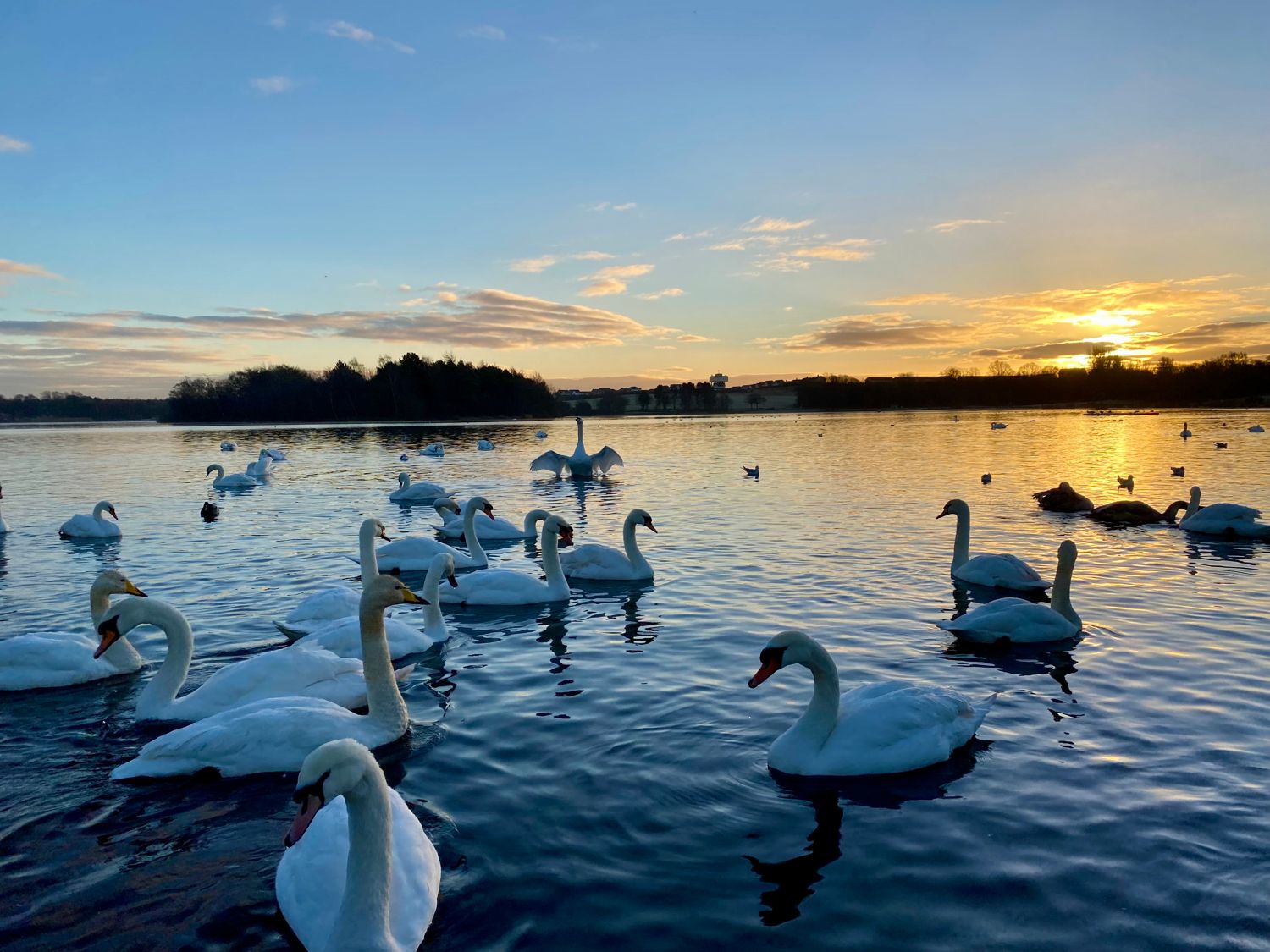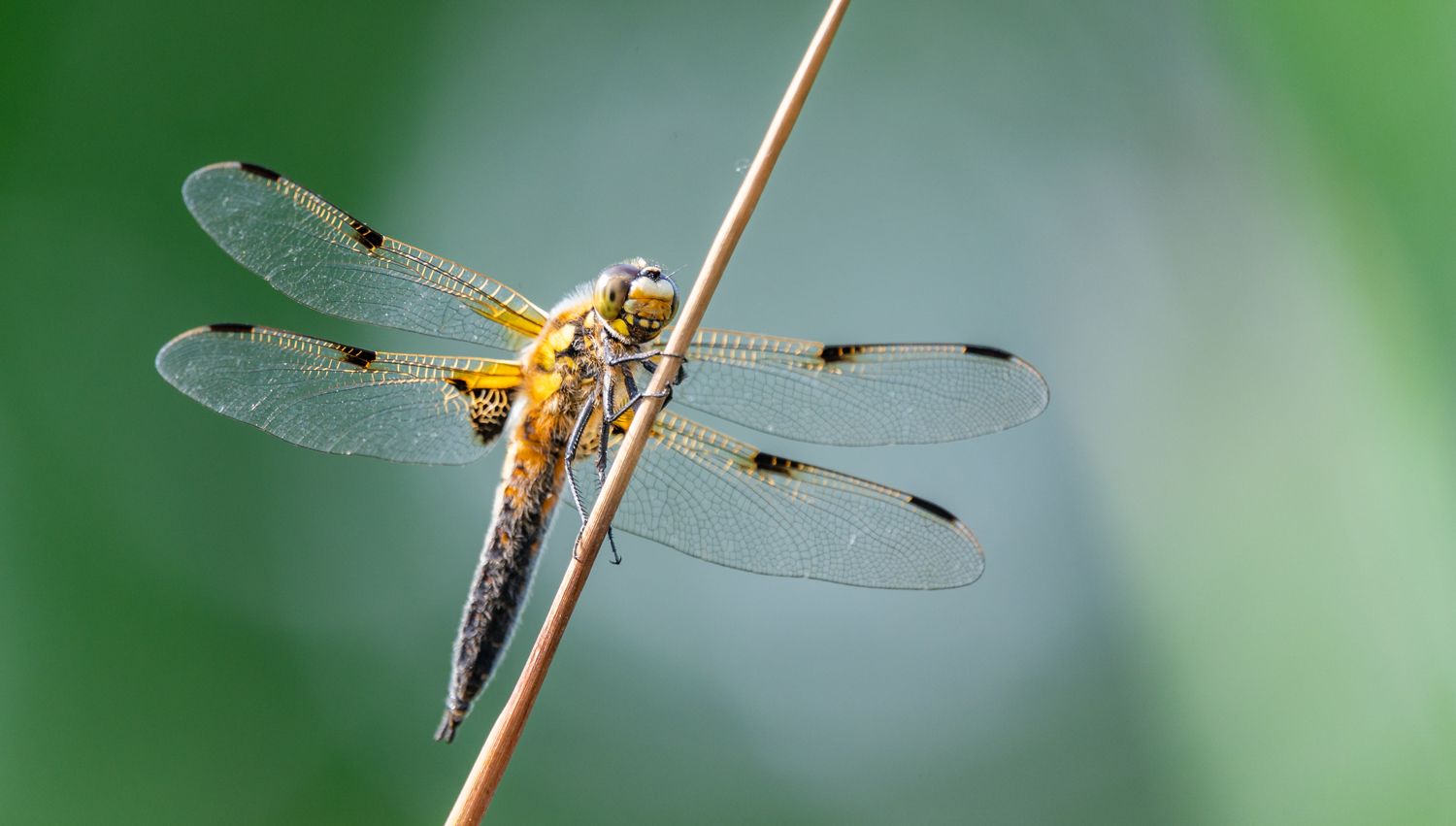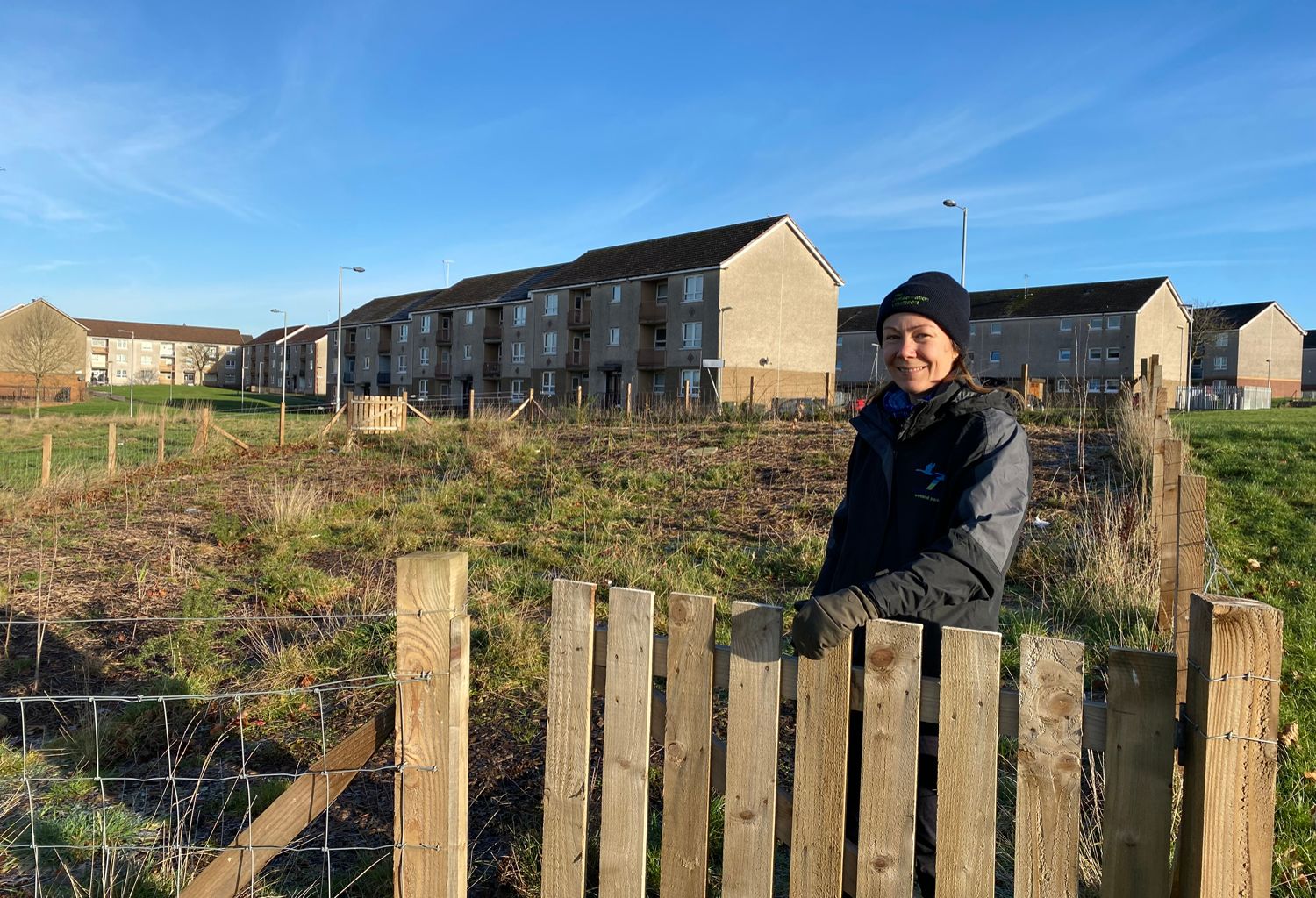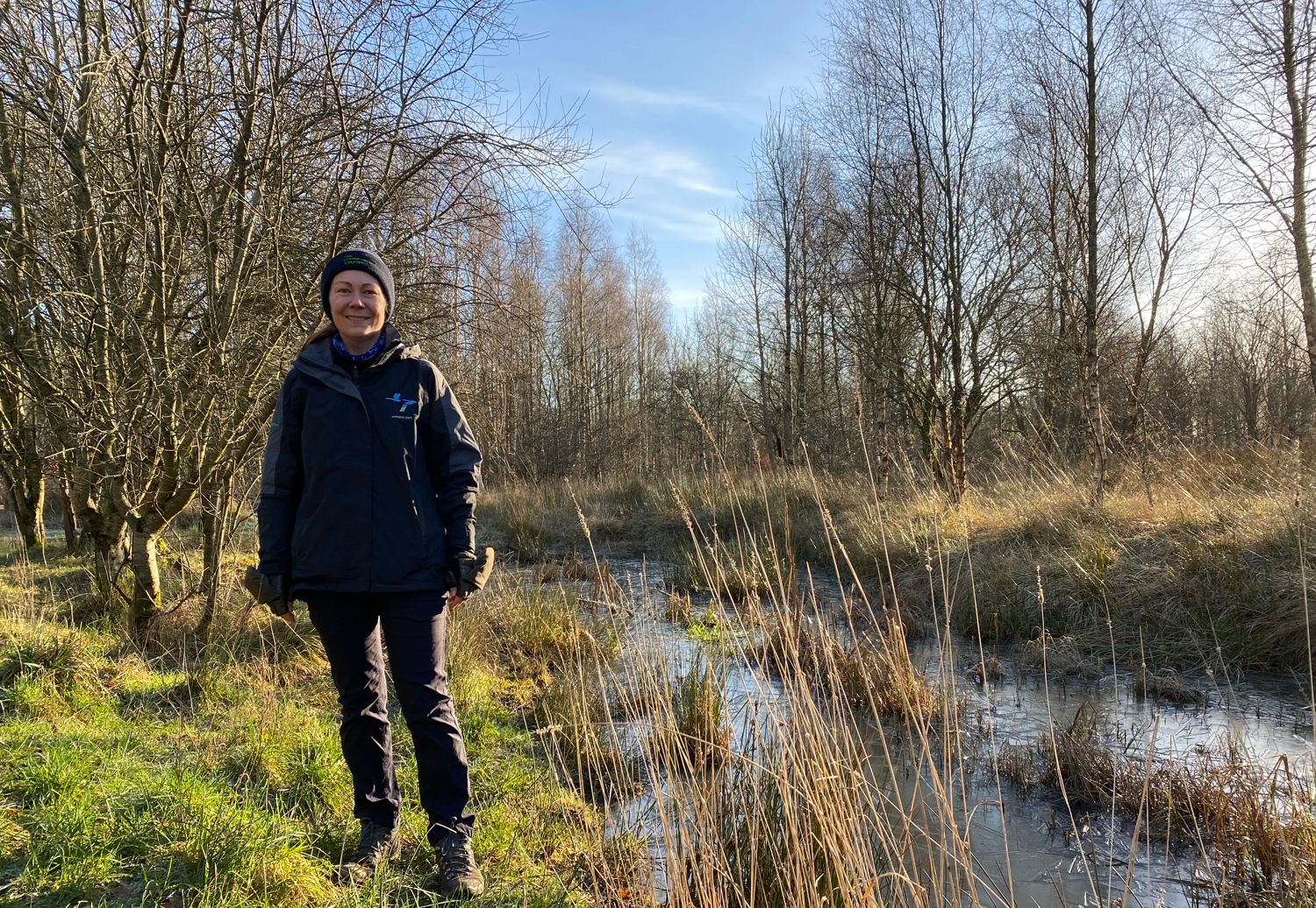If there has been one constant passion in Claire’s life, it’s bug hunting. “I was just one of those kids who grubbed around in the garden. All I wanted to do was bug hunt,” she tells me. Luckily, Claire gets to do a lot of bug hunting in her community engagement job with The Conservation Volunteers (TCV). For the last three years, she has been pond dipping, den building, and wildlife surveying at Seven Lochs, Scotland's largest urban nature park. Regularly working with visitors to the site, Claire shows kids, families, and adult volunteers where to look for millipedes and woodlice, how to dip into ponds with a net, and how to observe the snails, larvae, and other creatures usually missed by passers-by. She also spends time working with groups in the woods, teaching them how to create dens, and build fires safely. These activities have a clear purpose – to ensure that the local community can enjoy and celebrate the wonderful green space on their doorstep. On my walk and talk with Claire, I learned how she got into her current line of work, and what her role means for the communities she works with.
On location at Hogganfield Loch
When I arrive at Hogganfield Loch – one of the Seven Lochs – to meet Claire, the ground is crisp, and the winter sun rising up behind the nearby housing estate does little to warm me up. The car park is almost full – dog walkers march along the paths, friends talk their way around the loch. A group of international students take selfies with the whooper and mute swans behind them.
At 16 km², the Seven Lochs park is nearly five times the size of London’s Hampstead Heath. It stretches from Hogganfield Loch in the north east of Glasgow, along to Coatbridge in North Lanarkshire. The park is surrounded by housing estates, and it’s outlined and intersected by three nearby motorways. However, it’s difficult to tell that we’re in an urban space: the sights and sounds of people and birdlife offer a welcome distraction from nearby traffic. The hooting of the whooper swans and cries of the gulls fill the air. Moorhens dart among the swans, and mallards rest along the loch’s edge.

It’s easy to forget that Hogganfield Loch is in the central belt, one of the most densely populated areas of Scotland.
Moorhens rarely travel far. They’re constant residents here, content with feeding and nesting around the lochs, and capturing visitors' attention with their striking red beaks and black feathers as they swim among the white swans. The whooper swans, however, are visitors to the loch after leaving the Icelandic cold behind for the winter. Here at Hogganfield they’re a popular sight, attracting many visitors – today, a photographer is setting up his tripod and attaching a long lens in the direction of the whoopers as Claire arrives. With these scenes, it’s easy to forget that Hogganfield Loch is in the central belt, one of the most densely populated areas of Scotland. As Claire and I stroll around the park, we discuss careers, wildlife, working outdoors, and how it's possible to connect with nature, even in a busy area like this.
Career beginnings
There are nearly 50km of paths around the park. You’ll find routes for cycling and walking, and there are old concrete shelters overlooking the loch, which have been renovated by artists and members of the community. There are also ponds, grasslands, a canal, and Scotland’s first tiny forest to explore. We set out first on the Seven Lochs trail, to see some of the ponds and woodland nooks where Claire takes her volunteers and groups. Her job is to engage the community with the park and its environment – working in an urban area to bring wildlife and people together is what really drew her to this role.
“Since I was a child, I’ve wanted to change the environment for the better. And I think you have to start with people. They’re not going to care about what they don’t know,” she says. Claire, who grew up in London and moved to Stirling to study environmental sciences and biology, has volunteered in conservation since childhood. Whether it was the wildlife watch groups at school and university, or the conservation and schools outreach volunteering with the RSPB as an adult, Claire has always been an advocate for the value of volunteering. I’m impressed that she still makes the time for volunteering alongside her full-time work and family life.
“I’ve always felt volunteering was a really important part of life. It’s always been something I’ve done."
“I’ve always felt volunteering was a really important part of life. It’s always been something I’ve done. I volunteered with Sustrans and the RSPB and various organisations. Anything that could get me outside and doing stuff, getting experience and lots of training,” she says. Volunteering was also a way for Claire to get into conservation work, after bringing up a family. “I hadn't realised how hard it would be to get into work after having my children,” says Claire. She tells me that she met her husband Mike, a fellow volunteer and student, while at the University of Stirling. After university, Claire and Mike (now a ranger in nearby South Lanarkshire) had three kids. Their youngest is now 19.
Claire also acknowledges the difficulties that volunteering can present, and recognises that she was fortunate in being able to afford to volunteer, to acquire the experience she needed to work in conservation. “With three kids I couldn’t afford to put them into after-school and holiday care, and we didn’t have family up here to help. So I would volunteer when I wanted, and it fitted around family life,” says Claire. She felt that this was a lucky position to be in – she would look after the kids and then volunteer when she had time, building up a wide range of experience and skills. Eventually, that volunteering work led to paid work. “In the early days, volunteering wasn’t counted as proper work experience. Now it is,” she says.
Volunteers at Seven Lochs aren’t just here for work experience in conservation, however – they come for a mix of reasons. Many volunteer to socialise, or to give something back to their community. Students from Scotland’s Rural College (SRUC) come along to improve their identification skills and get practical experience. “We also suddenly have a lot of retired ladies, which is lovely,” says Claire. She has plans to get more adult volunteers involved from the nearby communities, and hopes to run a forest school for them, including (of course) some bug hunting activities.
Wildlife surveying and connecting with nature
We follow the trail away from the loch up through a tussocky grassland, where water voles – a rare species in the UK, but a common creature in the park – build their tunnels. I am surprised by how many there are living here, and hope to catch sight of one. “They’re everywhere. You can see them in winter still, but spring and summer are best. They spend much more time underground in winter,” she says. The water voles live near to the lochs and canal, their natural habitat, but also in the open grasslands and in some back gardens in nearby Easterhouse. I see holes in the grass where they pop their heads up, their deep chambers hidden underneath. Water voles are protected in the UK because there are so few of them left, but their numbers here at Seven Lochs are anything but small.
When I ask if any other rare or surprising species pop up in her volunteers’ wildlife surveys, Claire says: “No, we haven’t found anything wildly exciting. Actually, most of my volunteers are beginners at plant and wildlife identification. I often get new volunteers asking if it’s OK if they come out, even though they have little knowledge. We are happy to take all abilities,” she says. “They’re so excited about all this really common stuff – it’s lovely to see.” She’s also noticed that some of the children in her school groups haven’t had identification skills passed onto them by their parents: “We’ve got kids who don’t know what nettles are. Some of them have a real disconnect.”
Claire is tasked with remedying that disconnect through her activities, using sensory tactics to get people engaging with nature up close. They are encouraged to touch and smell, and sometimes taste, what they encounter. The focus is on experiencing nature, and Claire explains that there’s a lot of evidence that suggests learning the names of things isn’t as important as you might think for forming a connection with nature – “it’s sensory, so I’ve really embraced that in my sessions.”
We wind along the trail and cross into a densely planted young woodland, and arrive at one of the rain-fed ponds used with groups for pond dipping. The frosty grasses around the water’s edge are starting to thaw. I try and imagine it in summer with the trees in leaf and a group of kids, the SRUC students, or the retired ladies skimming the water with nets, chatting and putting their finds into water-filled trays to see what they can identify. Perhaps they will find some dragonfly larvae, water lice or a palmate newt. “This place is great for dragonflies, as it catches the sun and they all sit along there,” says Claire and she points to a bench at the end of the pond.

Perseverance pays off
We continue on our walk towards one of the forest school areas. A deer munching among the trees pauses as we approach. When we stop to look at her, she turns and walks calmly away. “They’re so used to people,” says Claire.
Although Claire has done a lot of training throughout her career, volunteering has been her biggest asset when she came to applying for jobs. “That’s the trouble, trying to get in from the outside is really tricky,” says Claire. “It’s definitely key – if you want to work somewhere like this, go and volunteer. Then they know you, and know you’re keen.” However, volunteering is not just about career progression for Claire; it has also been about connecting with people. She met her husband while volunteering, and she’s also made some really good friends over the years - “You are working with people who have the same interests, but not necessarily all of the same interests.”
“I applied for many, many TCV jobs and my perseverance paid off”
This isn’t Claire’s first community engagement role; she worked with Sustrans for a year to encourage active travel with schools. Sadly, like many grant-funded roles, the money ran out. Claire then worked in a series of zero-hour and non-contract jobs: “I had about six jobs going on for a year or two, but one of them was with OutLET: Play Resource and I absolutely loved that.” Volunteering in conservation alongside her paid work eventually secured Claire a job with TCV. “I applied for many, many TCV jobs and my perseverance paid off,” Claire smiles. “The variety I have with this job is amazing. I work with babies and older people, and everyone in between. You can see the difference you’ve made to people, and that’s really nice.”
TCV are one of seven partners in the Seven Lochs partnership, and when she was first in post, Claire’s aim was to work with school groups, often bringing classes of 20 or more out into the park. However, a change in funders and the impact of the Covid-19 pandemic meant that the scope of her work also changed. She could cast a wider net, work with smaller groups and engage with adults. Like many organisations, TCV also adapted their engagement to include online resources. They worked with the nature app Zepto Nature to make all of the activities Claire would normally do with groups available via the app, like bug hunting, shelter building, and wildlife recording. The Seven Lochs YouTube channel also features videos of nature connection activities, many of which were filmed during lockdown, when group visits weren’t possible.
Part of Claire’s role also involves showing school and nursery teachers how to engage their kids with outdoor learning. A local nursery were so happy with their CPD sessions that Claire has been asked back to upskill the rest of their staff in fire making and other nature-based skills. Additional Support Needs (ASN) schools are one of her current targets, and Claire has a couple that she works with regularly. She tells me about a group of children who had been struggling in class – they weren’t disruptive kids, but their quietness meant they had slipped under the radar. Claire was thrilled as the quieter ones started talking, and the noisier ones calmed down. As their teamwork improved, they began to listen more effectively, and by the end they worked very well as a group. I can see how happy this makes her. When she tells me about the difference her colleague Ali Lawson’s employability and training programme is having on a group of young people, her satisfaction is evident. It’s clear that community engagement – connecting people with nature – is good for Claire herself, as well as for the people she works with.
With TCV, she has had a lot of freedom to invent her own sessions, choose the groups she works with, and adapt as necessary. Working with schools and nurseries has been great, Claire tells me, but she is keen to reach out to more adults in the community. Running parent and child play sessions is one of her ways to get adults involved. “When you do school groups, the message doesn’t necessarily get home,” Claire explains.
Plans for the future
Claire’s role with TCV is grant-funded, but she’s optimistic that the value of what they’re doing is clear, and that the project will continue in some form. I ask her, nevertheless, what her career aspirations are for the future. “I’m totally unambitious when it comes to climbing the ladder, because I like what I’m doing,” says Claire. “But I’m always looking for ways to improve my sessions. I love going on training courses, networking and trying new things.” She’s aware of managerial jobs coming up from time to time with TCV, but feels this is not the right move at the moment. “If it means I’m on a laptop all day managing, I’m not really interested. I couldn’t not be getting out for at least half of the time.”
"I’m always looking for ways to improve my sessions. I love going on training courses, networking and trying new things.”
As we cross over an area of grassland at Easterhouse, I see hundreds of water vole holes criss-crossing the meadow, and forming lots of little craters. We come to the new tiny forest that will become a teaching area for Claire. It’s about the size of a tennis court, and is filled with 600 native trees using a planting technique developed by the Japanese botanist, Akira Miyawaki. Claire shows me small sections of old slabs among the trees, which will be used for future bug hunting missions. From here, we walk past Avenue End (one of the primary schools Claire works with) and through another housing estate, to reach the highest point on our walk. We can see over Hogganfield Loch to Cathkin Braes on the edge of Glasgow city, close to where Claire’s husband works as a ranger. The view takes you even further north to the Campsie Fells near Stirling. Down below us is Hogganfield Loch, and from this view I can’t see any people, only meadow and the water below.

As well as being outdoors, enjoying the green space, wildlife, and views, Claire enjoys seeing her volunteers each week, especially watching them develop and try new things. There are lots of students travelling out to the park from Glasgow, or people travelling in from other towns, as far as 10 miles away. Getting adult volunteers along from the nearby communities is challenging, but Claire persists and is working with community groups to spread the word.
A shared connection
When we arrive back at Hogganfield Loch, the paths are much busier than they were when we arrived this morning. There are still lots of dog walkers, but now I see grandchildren out with their grandparents, and parents out with their babies. The group of international students I saw when I first arrived has more than doubled in size: they’re still taking photos by the swans and chatting, take-away coffee cups in hand. A couple of Canada geese watch passing walkers, and a pair of mallards glide along beside them. They appear to be companions, temporarily brought together by the loch for the winter. A tufted duck (Claire’s favourite), follows us along the water’s edge. Tufties, as she calls them, are mainly resident birds. Their numbers can increase over winter, as some Iceland-dwelling tufties come to the UK before leaving again – like the whooper swans and barnacle geese – when warmer weather arrives. We are back at our starting point, and Claire heads away for an afternoon session with her wildlife volunteers.
I’m left with the thought that her volunteers are coming together a little like the bird life here at Hogganfield. Transient student volunteers join in for a term, people of all ages travel in from Glasgow city, and from commuter towns further afield. They mingle with the local volunteers. As the birds do, the volunteers find a connection with the place, and with each other at Seven Lochs: even if only for a few years, or just for a season. Friendships are formed while logs are turned over and bugs are discovered. A new community is created in this meeting place, and it’s Claire and her colleagues at the park who make this possible.
Related articles
Thinking of a job like Claire's in community engagement and environmental education? Find out more in these articles.
🌳 Follow TCV on Twitter: @TCVTweets and Facebook: @TheConservationVolunteers
👩🏼🌾 Can you see yourself working for TCV in a role like Claire's? Take a look at TCV's current vacancies

